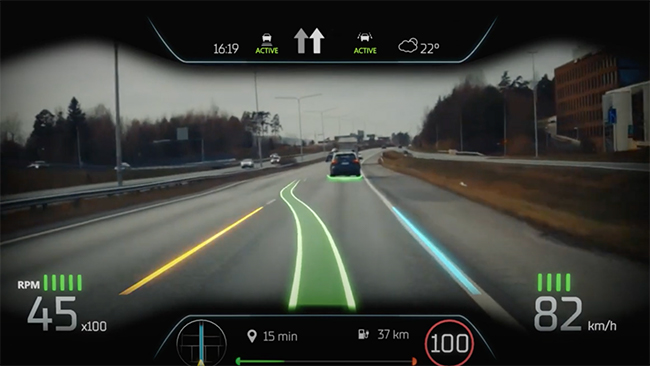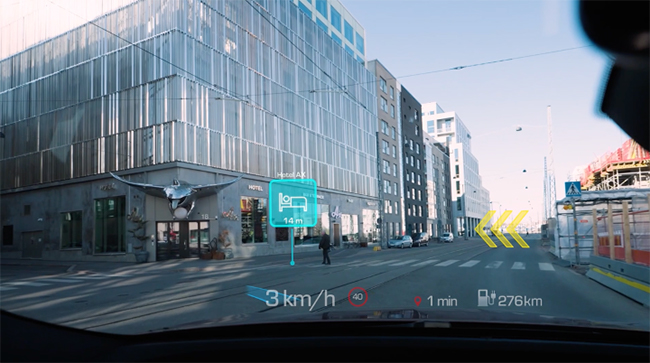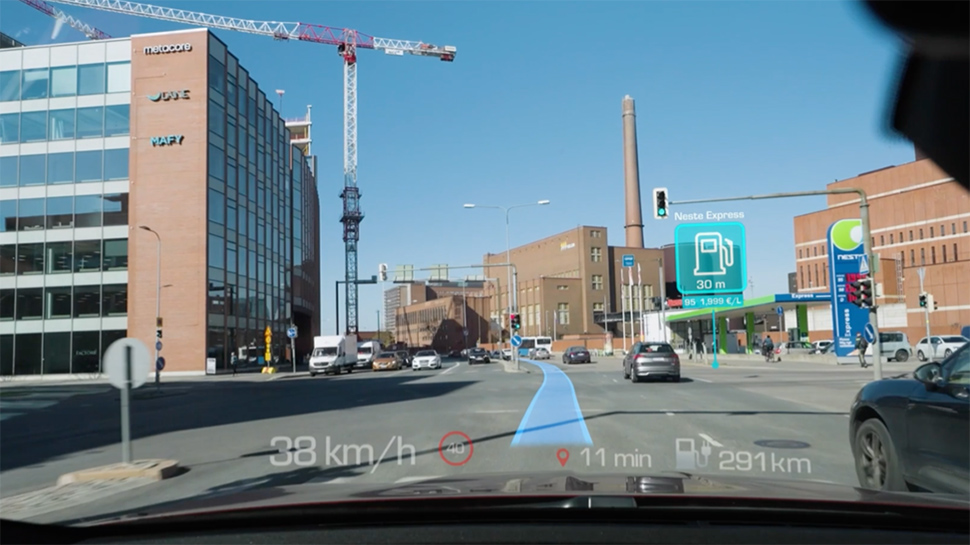
As augmented reality (AR) technology is entering the automotive space, AR navigation is quickly becoming one of the most demanded automotive AR use cases, offering groundbreaking convenience, efficiency, and safety for drivers. By seamlessly integrating navigation information into the real-world environment, AR navigation provides a more intuitive and user-friendly experience.
AR navigation in mobile phone applications is already being utilized for various purposes, including city and indoor navigation. As the technology matures, it is becoming a more common feature in vehicle navigation systems, providing drivers with a more intuitive and convenient way to navigate. Several automotive OEMs currently offer AR navigation features, such as the BMW and Mercedes-Benz, with more OEMs following.
The Limitations of Traditional Navigation Systems
Most vehicles today have built-in navigation systems. These traditional navigation systems prove to be highly convenient, especially when driving unfamiliar areas. However, the way navigation cues and information are displayed to the driver is not always the easiest to interpret, and it does not necessarily promote safe driving.
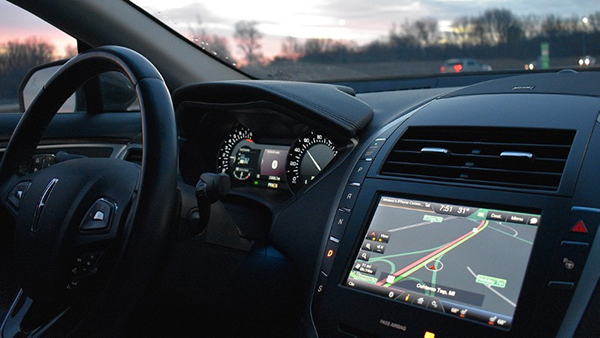
Image source: Pixabay
Constantly Having to Look Up and Down
One of the most significant challenges of using today’s navigation systems in our cars is the distraction that comes with constantly having to look up and down at your screen. One of the most common ways to use navigation in vehicles today, is to display it on the central display, or via your phone, which is placed somewhere in the center of the cockpit.
Whether you are using your phone or have the navigation displaying on the infotainment cluster, looking at the screen and then back at the road again dozens – if not hundreds – of times during your trip isn’t what could be considered a “safe driving habit”.
Traditional navigation systems require drivers to take their eyes off the road, which can increase the risk of accidents. The constant switching between the road and the navigation screen can also lead to mental fatigue, making drivers less attentive and slower to react to sudden changes in driving conditions.
Hard to Interpret Navigation Cues
Current in-vehicle navigation systems provide drivers with turn-by-turn instructions and other useful navigation cues. However, these instructions can sometimes be hard to interpret because they are not shown in the same context as your own driving view. For instance, using a 2D map or a birds-eye view may not be optimal for drivers to receive navigation instructions.
Moreover, map-based navigation systems heavily rely on audio instructions, which can be difficult to hear in noisy environments. This can lead to missed cues and misunderstandings, causing confusion and errors. Therefore, it is important to ensure that graphical cues are as intuitive as possible for the driver.
Lack of context relevant information
Traditional navigation systems typically provide limited information about the road ahead. Drivers may only receive information such as distance to the next turn, street names, and other basic information. The limited information can make it difficult to anticipate upcoming road conditions or make informed decisions about routing.
What is AR navigation?
With AR navigation you can solve many of the challenges mentioned above. Ultimately what makes AR navigation different from traditional navigation systems is that AR navigation allows the driver to get navigation cues directly onto the driver’s visual perception of the road, allowing for a more intuitive, accurate, and user-friendly navigation experience. By providing real-time information in the same view that the driver is seeing, drivers can stay focused on the road ahead while receiving the information they need to make informed driving decisions.
AR navigation can be displayed on different in-vehicle displays, such as:
- AR Heads-up display (AR HUD)
Projects the real-time navigation cues directly onto the vehicle’s windshield, enabling the driver to keep their eyes on the road while receiving navigation instructions.
- Instrument cluster
AR graphics enhanced video feed displayed in the instrument cluster behind the steering wheel.
- Infotainment display/Center screen
AR graphics enhanced video feed displayed in the center screen of the car.
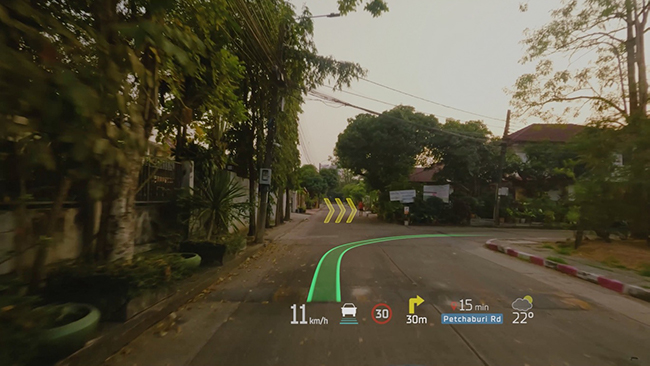
Example of AR navigation displayed on a HUD developed by Basemark.
In addition, AR navigation enables drivers with a more enhanced experience, due to unique AR features that are not always available in traditional navigation systems;
Lane Change Guidance
AR navigation provides clear visual representations of driving paths, ensuring drivers can stay in the correct lane and avoid confusion or abrupt lane changes. This feature proves particularly valuable during highway driving, where frequent lane splits or merges occur. By projecting navigation instructions directly onto the driver’s visual perception of the road, AR navigation enables drivers to easily recognise the appropriate lane to follow.
Example of Lane Change Guidance on an instrument cluster developed by Basemark.
Point-of-Interest (POI)
POIs encompass distinct locations or notable landmarks that hold significance or interest for drivers and users of the navigation system. Among the wide range of available POI categories such as restaurants, charging/gas stations, hotels, tourist attractions, and shopping centers.
Points-of-Interest are typically represented as virtual markers or icons superimposed on the live camera feed or displayed on a digital map. The purpose is to provide drivers with contextual information about their surroundings and make it easier to locate and navigate to desired destinations. Users can interact with the POIs through the navigation system, selecting them to obtain more information, reviews, or even initiate navigation to the chosen destination.
Example of AR navigation with POI feature for AR HUD developed by Basemark.
Street Names
AR navigation can also display street names directly on the driver’s view of the road. This can be particularly useful in areas where signs may be difficult to see or in urban environments where streets may be crowded or confusing.
Destination Arrival Experience
Another unique feature of AR navigation is the Destination Arrival Experience. With this feature, drivers can see an AR representation of their destination as they approach it. This can help drivers easily identify their destination, particularly in areas where buildings or landmarks may be obscured or difficult to see. It is also possible to display/highlight available parking spots, as well as parking rates.
Challenges of AR Navigation
Implementing AR navigation comes with a set of unique challenges that need to be taken into consideration.
Needs Precise Localization & Motion Tracking
Traditional GPS is not accurate enough for in-vehicle AR navigation experiences. Even a tiny error in calculating the pose & motion of the vehicle would result in a significantly poorer AR navigation experience. This leads the driver to experience a disconnect between the AR navigation overlays and the real world starts to feel like a distraction. The problem is usually amplified when driving over speed breakers, uneven roads etc. In some cases, such as driving over sloped roads, this may also lead the driver to make the wrong turn, completely defeating the purpose of AR navigation in the first place.
Understand the complexities of the real world
The real world is complex and not made of straight roads and perfect 90° bends. It’s full of lanes that suddenly split, roads that merge and confusing roundabouts. So AR navigation requires a lot of intelligence underneath to navigate through the complexities of the real world.
Avoid Latency & Motion Sickness
As we’re dealing with AR, you will constantly encounter latency concerns. Imagine a situation where you have AR navigation instructions showing on an AR HUD. Our vision is highly sensitive to the latency of AR content. For large displays, even a 20 ms delay can cause the AR content to feel laggy. This not only makes the AR content feel disconnected to the real world. But also tends to cause Motion Sickness for some people, leading to potentially dangerous scenarios.
Avoid blocking important info (Occlusion)
Occlusion is another critical consideration, particularly in the context of AR navigation on Windshield displays. AR navigation typically uses navigation arrows, magic carpet animations etc. to guide the driver on the right path. But when this is on the windshield there’s a high likelihood of AR content blocking important real-world objects, such as cars, pedestrians, traffic signs, traffic lights etc. So this can pretty quickly lead to a safety hazard.
The Future of Navigation
AR navigation revolutionizes driving by seamlessly integrating navigation information into the real-world environment. With intuitive cues projected onto the road, AR navigation enhances safety and offers additional features allowing for more immersive driving experience. Despite the implementation challenges, the vast technology advancements are making AR navigation a more common feature in vehicles today.
If you’re interested in learning how to solve the above problems and create truly immersive mixed reality AR experiences, Basemark can help you achieve it. We’ve launched hundreds of thousands of vehicles onto public roads with our AR software, and continue to work on the cutting edge of in-vehicle Augmented Reality. Find out more about Basemark’s automotive AR solutions here.
